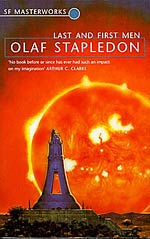
![]() Bormgans
Bormgans
5/30/2016
![]()
Reviewing fiction as old as this is always hard: how to judge a book that was written for an audience that is generally dead already? In a way, this book is alien itself.
I'll try to do justice to its historical relevance, and also say something about it as a contemporary reading experience.
This review is heavy on quotes that are often long. When I first started writing it, I typed in all the 21 quotes I considered using, and ended up with more than 1600 words already. I ditched a few, but quite a lot remain.
The final text has 3648 words. That's about an essay of 10 pages, so if you don't want to read an analysis of Olaf Stapledon's philosophical ambitions just skip the first section. If you're not interested in the importance of this book for SF as a genre, skip the second section too.
Last And First Men: A Story Of The Near And Far Future is not an easy book. It's 247 pages of small print, in an English that is still readable, but doesn't have a contemporary flow. The fact that Stapledon had a PhD in philosophy also shows: the conceptual content is pretty dense. A year after the publication of his first philosophical work, A Modern Theory Of Ethics: A Study Of The Relations Of Ethics And Psychology, he made his debut as a fiction writer with Last And First Men at age 44.
The book is set up as an historical account of the human race, and it describes the evolution from the 1930s onward, across two billion years, and eighteen distinct human species, of which our own is the first. There are no main characters, and the book reads more as a collection of history lessons than as a regular fictional story.
I'll discuss the conceptual & philosophical content first, then talk about its science fictional relevance, and end with some of the cons that colored my 2016 reading experience.
Please read the full analysis on Weighing A Pig...
https://schicksalgemeinschaft.wordpress.com/2016/05/30/last-and-first-men-olaf-stapledon-1930/